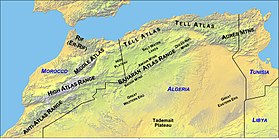
The Atlas Mountains are a mountain range in the Maghreb in North Africa. It separates the Sahara Desert from the Mediterranean Sea and the Atlantic Ocean; the name "Atlantic" is derived from the mountain range, which stretches around 2,500 km (1,600 mi) through Morocco, Algeria and Tunisia. The range's highest peak is Toubkal, which is in central Morocco, with an elevation of 4,167 metres (13,671 ft). The Atlas mountains are primarily inhabited by Berber populations.

Ouarzazate, nicknamed the door of the desert, is a city and capital of Ouarzazate Province in the region of Drâa-Tafilalet, south-central Morocco.

Jebel Musa is a mountain in the northernmost part of Morocco, on the African side of the Strait of Gibraltar. It is part of the Rif mountain chain. The mountain is generally identified as the southern Pillar of Hercules, Mons Abila.

Toubkal, also Jbel Toubkal or Jebel Toubkal, is a mountain in southwestern Morocco, located in the Toubkal National Park. At 4,167 m (13,671 ft), it is the highest peak in Morocco, the Atlas Mountains, North Africa and the Arab world. Located 63 km (39 mi) south of the city of Marrakesh, and visible from it, Toubkal is an ultra prominent peak, the highest for over 2,000 km (1,200 mi). Toubkal is ranked 27th by topographic isolation.

The High Atlas, also called the Grand Atlas, is a mountain range in central Morocco, North Africa, the highest part of the Atlas Mountains.
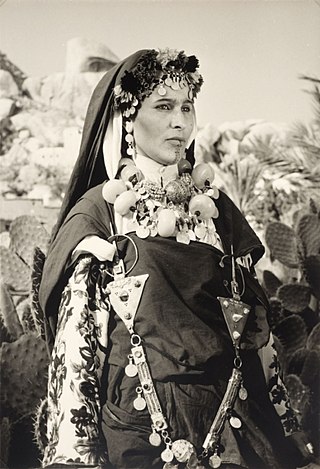
The Shilha people, or Schleuh or Ishelhien, are a Berber subgroup primarily inhabiting the Anti-Atlas, High Atlas, Sous valley, and Soussi coastal regions of Morocco.

The Middle Atlas is a mountain range in Morocco. It is part of the Atlas mountain range, a mountainous region with more than 100,000 km2, 15 percent of its landmass, rising above 2,000 metres. The Middle Atlas is the northernmost and second highest of three main Atlas Mountains chains of Morocco. To south, separated by the Moulouya and Um Er-Rbiâ rivers, lies the High Atlas. The Middle Atlas form the westernmost end of a large plateaued basin extending eastward into Algeria, also bounded by the Tell Atlas to the north and the Saharan Atlas to the south, both lying largely in Algeria. North of the Middle Atlas and separated by the Sebou River, lie the Rif mountains which are an extension of the Baetic System, which includes the Sierra Nevada in the south of Spain. The basin of the Sebou is not only the primary transportation route between Atlantic Morocco and Mediterranean Morocco but is an area, watered by the Middle Atlas range, that constitutes the principal agricultural region of the country.
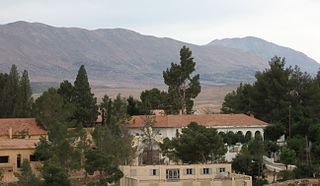
Jbel Ayachi is one of the highest mountains in North Africa, and anchors the Eastern High Atlas in central Morocco. Jbel Ayachi rises to a height of 3,757 m above sea level.
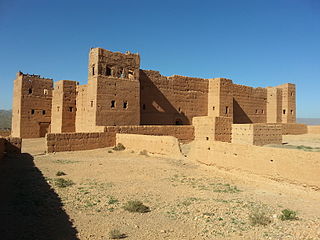
Tamnougalt is a kasbah and date palm oasis in the Atlas Mountains, and located in the Draa River valley in Morocco, some 75 kilometers south of Ouarzazate. The village is close to Agdz and has a famous kasbah. The Jbel Kissane rises to the north dominating the landscape. It is the former capital of the Mezguita region and residence of former caïds. Its name means 'meeting point' in Tachelhit. Each year, in the first week of October the Moussem Ellama is held, a cultural and religious festival for all villages in the neighbourhood.

Central Atlas Tamazight or Atlasic is a Berber language of the Afroasiatic language family spoken by 3.1 million speakers.

The Mediterranean woodlands and forests is an ecoregion in the coastal plains, hills, and mountains bordering the Mediterranean Sea and Atlantic Ocean in North Africa. It has a Mediterranean climate, and is in the Mediterranean forests, woodlands, and scrub biome.
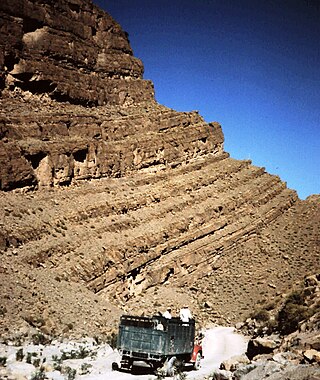
The Aganane Formation is a Pliensbachian geologic formation in the Azilal, Béni-Mellal, Ouarzazate, Tinerhir and Errachidia provinces, central Morocco, being the remnant of a local massive Carbonate platform, and known mostly for its rich tracksites including footprints of thyreophoran, sauropod and theropod dinosaurs. This formation has been dated to the Pliensbachian stage of the Lower Jurassic, thanks to the find of the ammonite Arieticeras cf. algovianum, indicator of Middle Domerian in the upper zone, and lower delimitation by the foraminifers Mayncina termieri and Orbitopsella praecursor. The dinosaur tracksites are all located a few metres below the Pliensbachian-Toarcian limit, being coeval and connected with the lowermost layers of the continental Azilal Formation. The Aganane Formation was also coeval with the Jbel Taguendouft Formation and the Tamadout 1 Formation, all developed along a local "platform-furrow" in the Middle Atlas Mountains, that act as a barrier controlling the western border of the Jurassic Atlas Gulf. The nearshore sections, including both carbonate platforms and close to sea terrestrial facies where located on an isolated internal domain thanks to the control of the barrier, allowing the Aganane Formation to develop on a hot and humid climate, where a local algal marsh had intermittent progradations, intercalated with a layer of terrigenous continental origin. The ichnosites were developed in tidal flats and coastal deposits suitable to sea flooding.

Skoura is a town in Ouarzazate Province, Drâa-Tafilalet, Morocco. It consists of a modern town as well as a historical oasis and palmeraie with traditional rammed-earth architecture.

The Jbel Saghro or Djebel Sahrho is a mountain range in south- east Morocco. It is located south of the High Atlas and east of the Anti-Atlas in the northwest of Africa, northeast of Taliouine and southwest of Ouarzazate.

Jebel Kelti is a mountain in the Tanger-Tetouan-Al Hoceima region, Morocco. It is located south of Tetouan in Chefchaouen Province. This mountain is part of the Rif mountain chain.
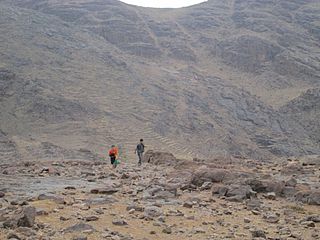
Mount Aklim, Jbel Aklim, is a mountain of the Souss-Massa region of Morocco. Its altitude is 2,531 m.
Mount Tidighin, Jbel Tidighin, Adrar N Tidighin, is a mountain in Al Hoceïma Province, Tanger-Tetouan-Al Hoceima, Morocco. Its summit elevation is 2,456 metres (8058').
The geology of Morocco formed beginning up to two billion years ago, in the Paleoproterozoic and potentially even earlier. It was affected by the Pan-African orogeny, although the later Hercynian orogeny produced fewer changes and left the Maseta Domain, a large area of remnant Paleozoic massifs. During the Paleozoic, extensive sedimentary deposits preserved marine fossils. Throughout the Mesozoic, the rifting apart of Pangaea to form the Atlantic Ocean created basins and fault blocks, which were blanketed in terrestrial and marine sediments—particularly as a major marine transgression flooded much of the region. In the Cenozoic, a microcontinent covered in sedimentary rocks from the Triassic and Cretaceous collided with northern Morocco, forming the Rif region. Morocco has extensive phosphate and salt reserves, as well as resources such as lead, zinc, copper and silver.
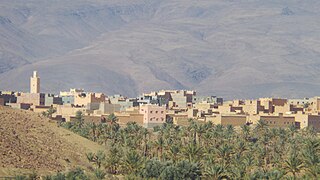
N'Kob is a rural municipality in the Zagora province, in the Atlas Mountains. It is located near the Jbel Saghro and 24 kilometers from Tamsahelte. N'Kob is situated 35 kilometers west of the commune of Tazzarine and 40 kilometers from the intersection with the Draa Valley (Tansikht), the most spectacular stretch of the N9. The village has 45 Kasbahs and is surrounded by two oases full of palm trees, numerous of these ancient kasbahs have now been renovated and became hotels. The most widely spoken language in this region is Shilha (Tamazight). According to results of the 2014 general census of the population and households, the village has a population of about 7,209 people.

Kasbah Taourirt is a historic fortified residence complex or kasbah in Ouarzazate, Morocco.

